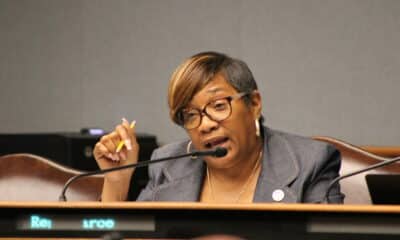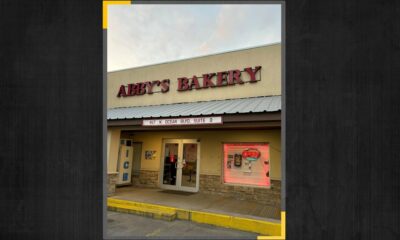Kaiser Health News
California’s $12 Billion Medicaid Makeover Banks on Nonprofits’ Buy-In
Angela Hart
Thu, 16 May 2024 09:00:00 +0000
TURLOCK, Calif. — For much of his young life, Jorge Sanchez regularly gasped for air, at times coughing so violently that he’d almost throw up. His mother whisked him to the emergency room late at night and slept with him to make sure he didn’t stop breathing.
“He’s had these problems since he was born, and I couldn’t figure out what was triggering his asthma,” Fabiola Sandoval said of her son, Jorge, now 4. “It’s so hard when your child is hurting. I was willing to try anything.”
In January, community health workers visited Sandoval’s home in Turlock, a city in California’s Central Valley where dust from fruit and nut orchards billows through the air. They scoured Sandoval’s home for hazards and explained that harsh cleaning products, air fresheners, and airborne dust and pesticides can trigger an asthma attack.
The team also provided Sandoval with air purifiers, a special vacuum cleaner that can suck dust out of the air, hypoallergenic mattress covers, and a humidity sensor — goods that retail for hundreds of dollars. Within a few months, Jorge was breathing easier and was able to run and play outside.
The in-home consultation and supplies were paid for by Medi-Cal, California’s Medicaid health insurance program for low-income residents. Gov. Gavin Newsom is spearheading an ambitious $12 billion experiment to transform Medi-Cal into both a health insurer and a social services provider, one that relies not only on doctors and nurses, but also community health workers and nonprofit groups that offer dozens of services, including delivering healthy meals and helping homeless people pay for housing.
These groups are redefining health care in California as they compete with businesses for a share of the money, and become a new arm of the sprawling Medi-Cal bureaucracy that serves nearly 15 million low-income residents on an annual budget of $158 billion.
But worker shortages, negotiations with health insurance companies, and learning to navigate complex billing and technology systems have hamstrung the community groups’ ability to deliver the new services: Now into the third year of the ambitious five-year experiment, only a small fraction of eligible patients have received benefits.
“This is still so new, and everyone is just overwhelmed at this point, so it’s slow-going,” said Kevin Hamilton, a senior director at the Central California Asthma Collaborative.
The collaborative has served about 3,650 patients, including Sandoval, in eight counties since early 2022, he said. It has years of experience with Medi-Cal patients in the Central Valley and has received about $1.5 million of the new initiative’s money.
By contrast, CalOptima Health, Orange County’s primary Medi-Cal insurer, is new to offering asthma benefits and has signed up 58 patients so far.
“Asthma services are so difficult to get going” because the nonprofit infrastructure for these services is virtually nonexistent, said Kelly Bruno-Nelson, CalOptima’s executive director for Medi-Cal. “We need more community-based organizations on board because they’re the ones who can serve a population that nobody wants to deal with.”
Newsom, a Democrat in his second term, says his signature health care initiative, known as CalAIM, seeks to reduce the cost of caring for the state’s sickest and most vulnerable patients, including homeless Californians, foster children, former inmates, and people battling addiction disorders.
In addition to in-home asthma remediation, CalAIM offers 13 broad categories of social services, plus a benefit connecting eligible patients with one-on-one care managers to help them obtain anything they need to get healthier, from grocery shopping to finding a job.
The 25 managed-care insurance companies participating in Medi-Cal can choose which services they offer, and contract with community groups to provide them. Insurers have hammered out about 4,300 large and small contracts with nonprofits and businesses.
So far, about 103,000 Medi-Cal patients have received CalAIM services and roughly 160,000 have been assigned personal care managers, according to state data, a sliver of the hundreds of thousands of patients who likely qualify.
“We’re all new to health care, and a lot of this is such a foreign concept,” said Helena Lopez, executive director of A Greater Hope, a nonprofit organization providing social services in Riverside and San Bernardino counties, such as handing out baseball cleats to children to help them be active.
Tiffany Sickler runs Koinonia Family Services, which offers California foster children mental health and other types of care, and even helped a patient pay off parking tickets. But the program is struggling on a shoestring budget.
“If you want to do this, you have to learn all these new systems. It’s been a huge learning curve, and very time-consuming and frustrating, especially without adequate funding,” she said.
Brandon Richards, a Newsom spokesperson, defended CalAIM, saying that it was “on the cutting edge of health care” and that the state was working to increase “awareness of these new services and support.”
For nonprofits and businesses, CalAIM is a money-making opportunity — one that top state health officials hope to make permanent. Health insurers, which receive hefty payments from the state to serve more people and offer new services, share a portion with service providers.
In some places, community groups are competing with national corporations for the new funding, such as Mom’s Meals, an Iowa-based company that delivers prepared meals across the United States.
Mom’s Meals has an advantage over neighborhood nonprofit groups because it has long served seniors on Medicare and was able to immediately start offering the CalAIM benefit of home-delivered meals for patients with chronic diseases. But even Mom’s Meals isn’t reaching everyone who qualifies, because doctors and patients don’t always know it’s an option, said Catherine Macpherson, the company’s chief nutrition officer.
“Utilization is not as high as it should be yet,” she said. “But we were well positioned, because we already had departments to do billing and contracting with health care.”
Middleman companies also have their eye on the billions of CalAIM dollars and are popping up to assist small organizations to go up against established ones like Mom’s Meals. For instance, the New York-based Nonprofit Finance Fund is advising homeless service providers how to get more contracts and expand benefits.
Full Circle Health Network, with 70 member organizations, is helping smaller nonprofit groups develop and deliver services primarily for families and foster children. Full Circle has signed a deal with Kaiser Permanente, allowing the health care giant to access its network of community groups.
“We’re allowing organizations to launch these benefits much faster than they’ve been able to do and to reach more vulnerable people,” said Camille Schraeder, chief executive of Full Circle. “Many of these are grassroots organizations that have the trust and expertise on the ground, but they’re new to health care.”
One of the biggest challenges community groups face is hiring workers, who are key to finding eligible patients and persuading them to participate.
Kathryn Phillips, a workforce expert at the California Health Care Foundation, said there isn’t enough seed money for community groups to hire workers and pay for new technology platforms. “They bring the trust that is needed, the cultural competency, the diversity of languages,” she said. “But there needs to be more funding and reimbursement to build this workforce.”
Health insurers say they are trying to increase the workforce. For instance, L.A. Care Health Plan, the largest Medi-Cal insurer in California, has given $66 million to community organizations for hiring and other CalAIM needs, said Sameer Amin, the group’s chief medical officer.
“They don’t have the staffing to do all this stuff, so we’re helping with that all while teaching them how to build up their health care infrastructure,” he said. “Everyone wants a win, but this isn’t going to be successful overnight.”
In the Central Valley, Jorge Sanchez is one of the lucky early beneficiaries of CalAIM.
His mother credits the trust she established with community health workers, who spent many hours over multiple visits to teach her how to control her son’s asthma.
“I used to love cleaning with bleach” but learned it can trigger breathing problems, Sandoval said.
Since she implemented the health workers’ recommendations, Sandoval has been able to let Jorge sleep alone at night for the first time in four years.
“Having this program and all the things available is amazing,” said Sandoval, as she pointed to the dirty dust cup in her new vacuum cleaner. “Now my son doesn’t have as many asthma attacks and he can run around and be a normal kid.”
This article was produced by KFF Health News, which publishes California Healthline, an editorially independent service of the California Health Care Foundation.
——————————
By: Angela Hart
Title: California’s $12 Billion Medicaid Makeover Banks on Nonprofits’ Buy-In
Sourced From: kffhealthnews.org/news/article/newsom-medicaid-12-billion-dollar-makeover-nonprofits-bureacracy-calaim/
Published Date: Thu, 16 May 2024 09:00:00 +0000
Kaiser Health News
Texas Measles Outbreak Nears 100 Cases, Raising Concerns About Undetected Spread
SUMMARY: A measles outbreak in West Texas has led to private school closures, overwhelming local health departments. Since the outbreak began three weeks ago, 90 cases have been confirmed, mostly in children under 18, with 16 hospitalizations. Health officials fear the outbreak will worsen, and some parents may be avoiding testing their children. The outbreak has been exacerbated by low vaccination rates, particularly in communities like Gaines, which has one of the lowest vaccination rates in Texas. Local officials are working to contain the virus through pop-up clinics, mobile testing, and educating schools, but the situation remains challenging.
The post Texas Measles Outbreak Nears 100 Cases, Raising Concerns About Undetected Spread appeared first on kffhealthnews.org
Kaiser Health News
GOP Takes Aim at Medicaid, Putting Enrollees and Providers at Risk
SUMMARY: Republicans are again targeting Medicaid, proposing significant funding cuts to finance President Trump’s agenda on tax cuts and border security. Approximately 79 million people rely on Medicaid and the Children’s Health Insurance Program (CHIP), vital for numerous hospitals and states. Amid Democratic resistance, potential cuts could include reducing federal matching funds and imposing work requirements, which critics argue adds unnecessary barriers. Historically controversial, these efforts reflect deep partisan divides over Medicaid’s role as a safety net versus a welfare program. Many Americans favor Medicaid, making proposed cuts politically sensitive. The outcome remains uncertain as GOP leaders face internal challenges.
The post GOP Takes Aim at Medicaid, Putting Enrollees and Providers at Risk appeared first on kffhealthnews.org
Kaiser Health News
An Ice Rink To Fight Opioid Crisis: Drug-Free Fun vs. Misuse of Settlement Cash
SUMMARY: Carter County, Kentucky, has controversially spent $15,000 of its opioid settlement funds on an ice rink, raising concerns about its relevance to the ongoing opioid crisis. Advocates argue that resources could be better allocated to overdose prevention, such as Narcan kits or local substance abuse programs. Brittany Herrington, a local in recovery, criticized the decision as neglecting community needs. While officials claim the rink fosters drug-free youth activities, critics note it lacks direct ties to combating addiction. Local leaders are calling for stricter oversight on how settlement funds are used, emphasizing the need for targeted support in addressing substance use disorders.
The post An Ice Rink To Fight Opioid Crisis: Drug-Free Fun vs. Misuse of Settlement Cash appeared first on kffhealthnews.org
-

 News from the South - Louisiana News Feed2 days ago
News from the South - Louisiana News Feed2 days agoJeff Landry’s budget includes cuts to Louisiana’s domestic violence shelter funding
-

 News from the South - North Carolina News Feed3 days ago
News from the South - North Carolina News Feed3 days agoBills from NC lawmakers expand gun rights, limit cellphone use
-

 News from the South - North Carolina News Feed7 days ago
News from the South - North Carolina News Feed7 days agoModest drops in some North Carolina prices under Trump | North Carolina
-

 News from the South - Arkansas News Feed7 days ago
News from the South - Arkansas News Feed7 days agoTiming out the incoming winter weather
-

 News from the South - Oklahoma News Feed5 days ago
News from the South - Oklahoma News Feed5 days agoRemains of Aubrey Dameron found, family gathers in her honor
-

 News from the South - Texas News Feed3 days ago
News from the South - Texas News Feed3 days agoICE charges Texas bakery owners with harboring immigrants
-

 News from the South - Florida News Feed7 days ago
News from the South - Florida News Feed7 days agoExpert discusses how deportations could cause labor shortages for several industries
-

 News from the South - South Carolina News Feed6 days ago
News from the South - South Carolina News Feed6 days agoSC Flu cases on the rise: Prisma Health Doctors speak out on how to spot symptoms, get treatment













































